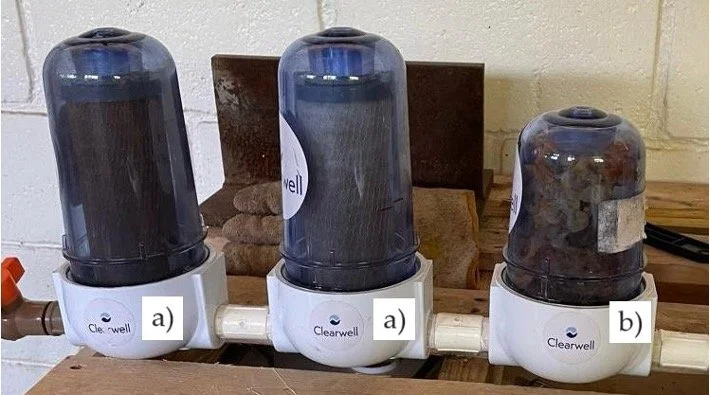Removal of sulfate ion from mining effluents using adsorption fibers
ABSTRACT
Introduction:
With freshwater resources becoming scarcer, the demand for effective use of water resources in mining is increasing. Thereby, wastewater treatment technologies present themselves as strong alternatives, as they allow water reuse. The presence of high concentrations of sulfate ions in water bodies affects their potability and usefulness both for irrigation and industrial use. Adsorption is a promising method due to its ability to reduce sulfate concentration to low levels. This method consists of retaining particles on the surface of solids through chemical or physical interactions. The objective of this paper is to study the adsorption fiber technology designed by the company Clearwell, evaluating its potential for removing sulfate ions from mining effluents of the company NEXA Resources and its feasibility for scaling.
Methodology:
For the treatment system shown in figure 1, two activated carbon pre-filters (a) were connected in series and then connected to a capsule containing H fiber (b), intended for sulfate removal. In test 1, the feed stream was a mining wastewater at pH 9, called effluent 1, that was pumped into the system using a peripheral pump. As soon as the flow in the outlet tube was observed, the timer was started, and the system's outflow was monitored. In addition, samples of 40 mL were collected in the outlet stream every 1 minute until fiber saturation, defined by the point when the outflow conductivity equalled the initial conductivity, measured by a conductivity meter. The sample collected in minute 3, denominated sample 1, and the feed stream effluent were analyzed by an Inductively Coupled Plasma Optical Emission Spectroscopy (ICP-OES) at Campo Análise laboratory, in Brazil. Finally, the fibers were immersed in 1 L of a sodium hydroxide solution at a concentration of 3% weight/volume for 15 minutes and subsequently washed with distilled water to be reactivated.
This procedure was repeated in test 2, but effluent 2 was used as feed stream, which was a mining wastewater at pH 3, and the sample was collected in minute 2 and was denominated sample 2.
Results and Conclusions:
Table 1 Characterization of samples and effluents
The test 1 lasted 25 minutes and the flow rate was approximately 180 mL/min, and test 2 lasted 58 minutes and the flow rate was approximately 100 mL/min. As shown in table 1, both tests presented a significant reduction in sulfate concentration, with a treatment percentage of 95.5% for test 1 and 99.0% for test 2. Lower flow rate favors a good treatment percentage, since there’s more contact time of the sulfate with the fiber adsorption sites, allowing better adsorption. In either case, conductivity in samples 1 and 2 are lower than its effluents due to the lower sulfate concentration in samples.
The flow rate suffered small fluctuations throughout the process due to the limitations of the pump. Furthermore, the reactivation process demands a high volume of reactivating solution (1 L) for the amount of effluent treated (only 4.5 L to 5.8 L). Therefore, new studies are being made with better flow control and regeneration in a closed system.
Finally, despite the need for process optimization, the fibers were effective in removing sulfate under different operating conditions, such as pH and sulfate concentrations.
*Corresponding author: Escalab – Department of Chemistry, Universidade Federal de Minas Gerais, Analyst, 2000 José Cândido da Silveira Ave, Belo Horizonte, Minas Gerais, 31035-536, Brazil. Phone: +55 31 997122611. Email: gabrielaluiza2001@gmail.com


